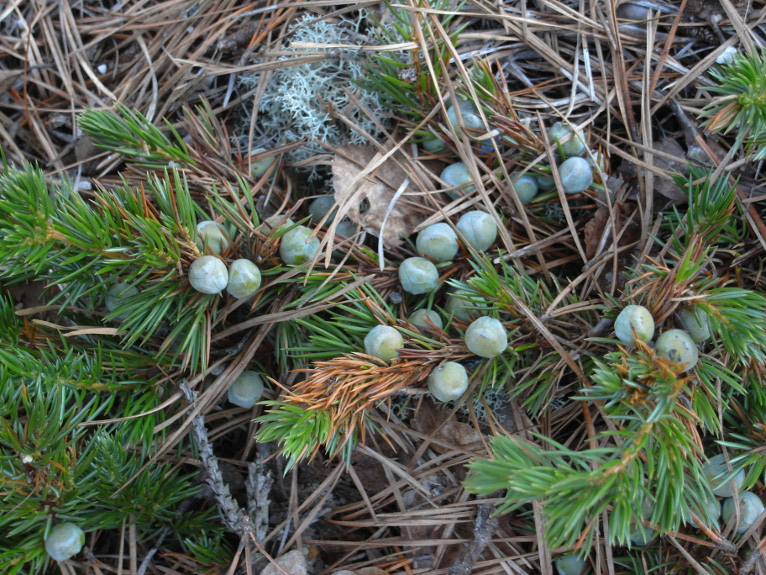
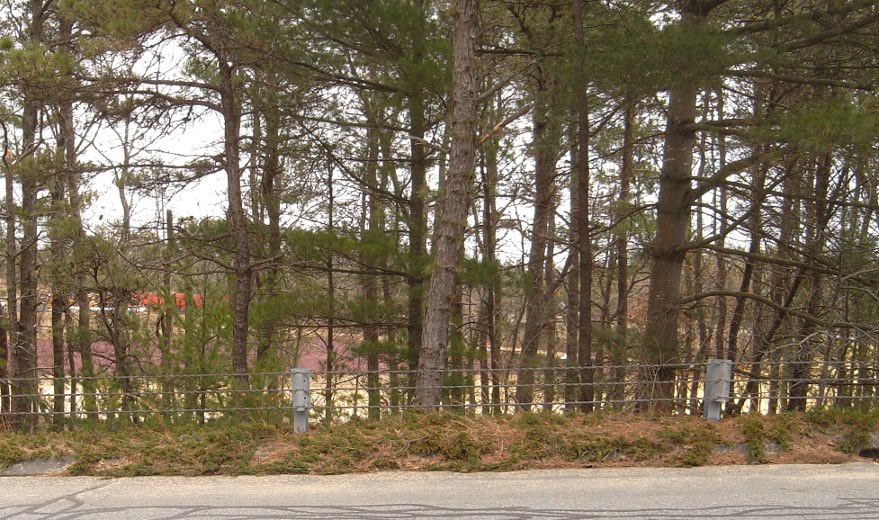
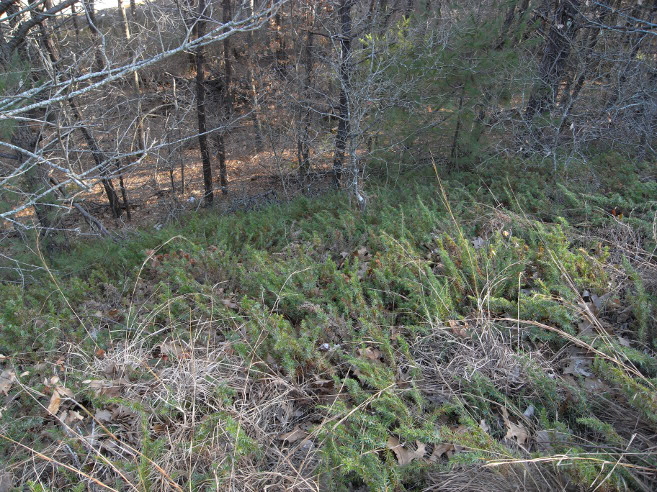
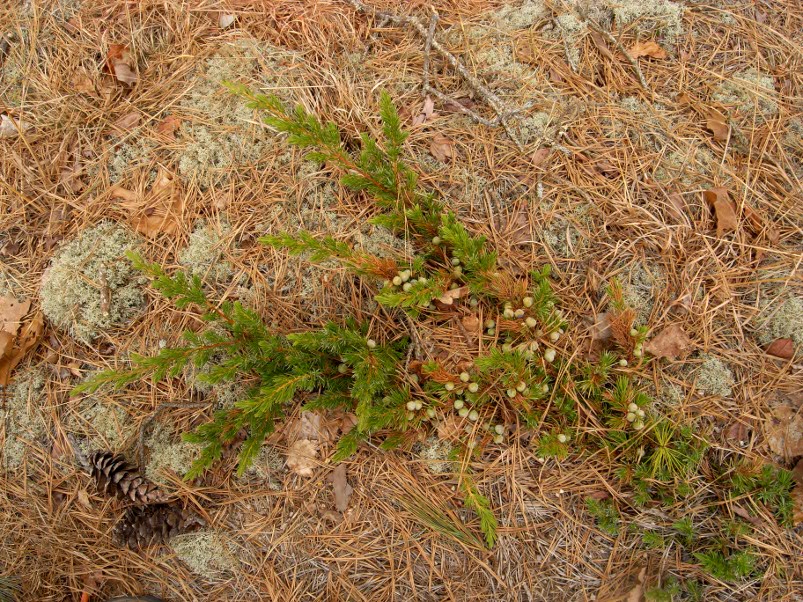
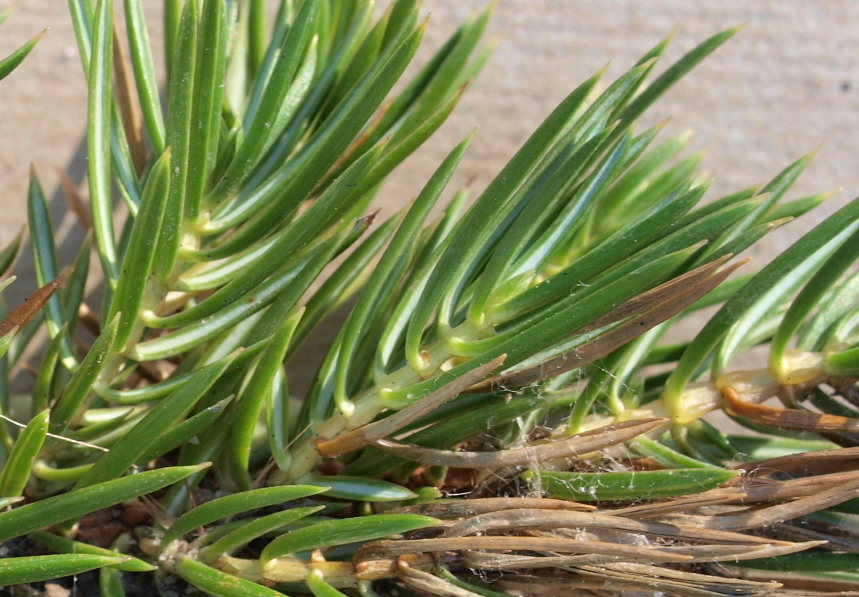
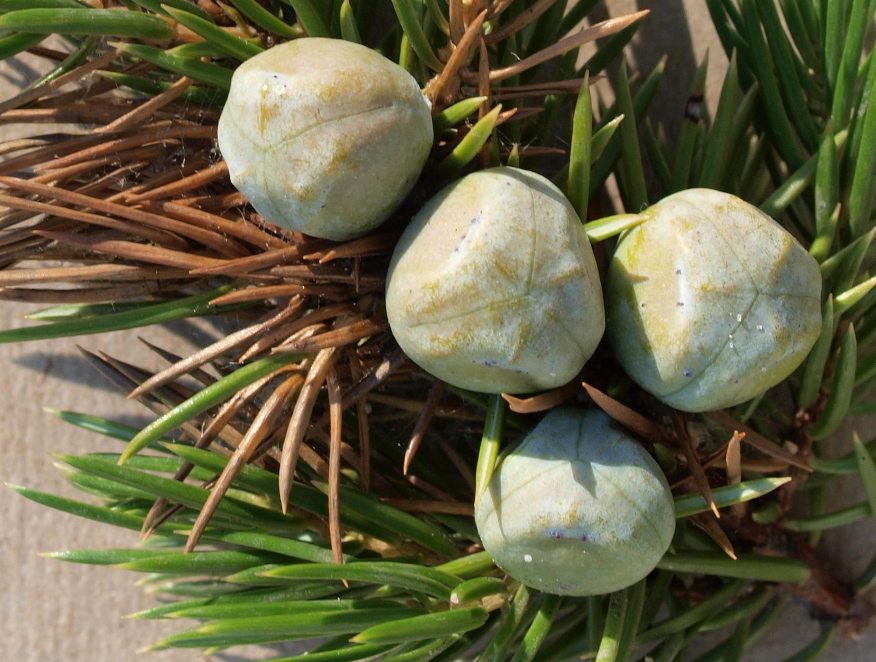
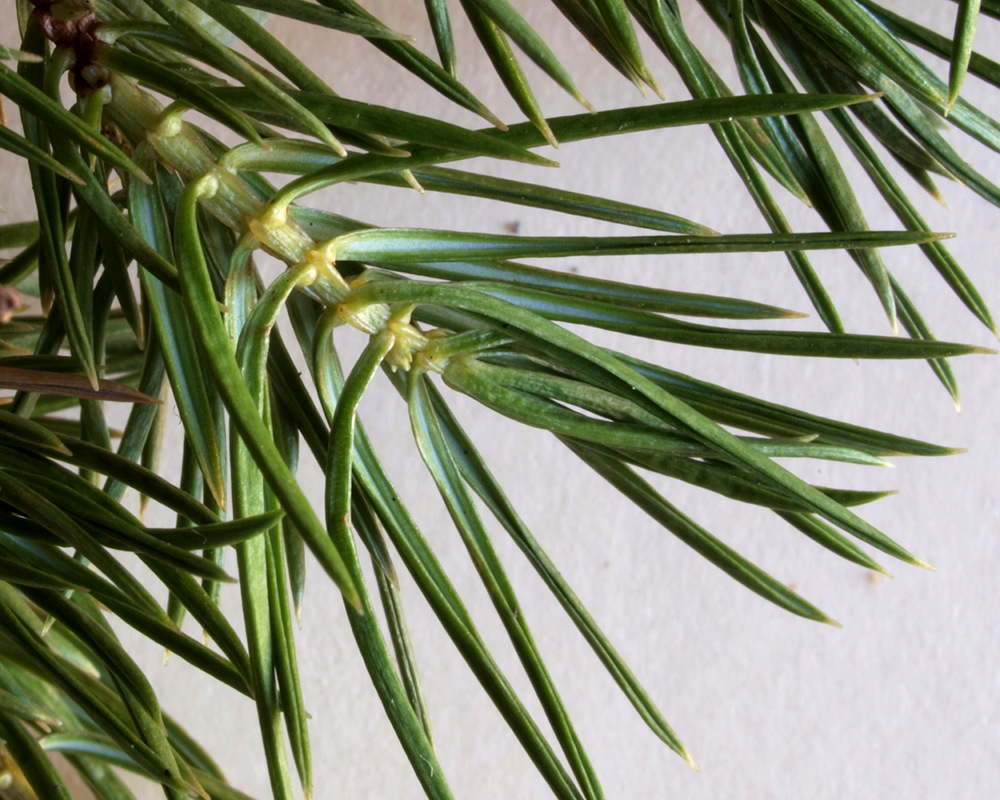
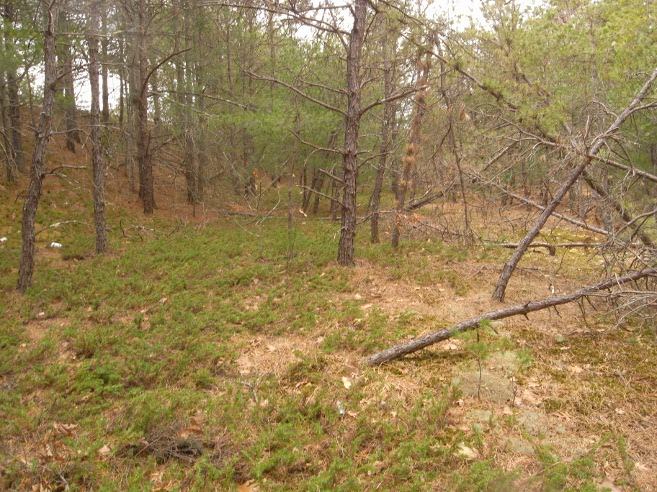

Japanese shore juniper (Juniperus conferta Parl.)
found naturalized in southeastern Massachusetts
Introduction
The recent general decline of the native common juniper
(Juniperus communis var.
depressa Pursh), which we have been observing in
eastern Massachusetts, can be readily explained by the plant's light requirements.
A rapid process of reforestation of post-agricultural and other man-made
forest openings has resulted in decline of many sun-loving native species
including junipers. Fertile, healthy common-juniper clones in eastern
Massachusetts have become exceedingly rare. One patch of common juniper
growing along Ponkapoag Trail in the Blue Hills Reservation has literally
disappeared within five-six
years in front of our eyes. That's why our attention was attracted to a
large, healthy, fertile population of a prostrate juniper on slopes of a
road/ramp crossing a highway and aggressively spreading down into sparse
pine forest.
The juniper covers man-made slopes of a ramp in Wareham,
MA, where Charge Pond Road crosses a state highway, Rt. 25. Wareham is a
Greater Boston's South Shore community and a gateway to Cape Cod: Rt. 25
is leading to Bourne Bridge built across the Cape Cod Canal. Present on
both eastern and western slope of the ramp crossing
Rt. 25 and on both northern and southern side of the highway, the
population is covering an estimated total area of about 0.5 acres (2,000
sq. m), producing abundant cones in its most lighted
parts.
A closer examination of samples has shown that the plant, even
though much resembling the native common juniper, appears to be Japanese
shore juniper, J. conferta Parl.
Introduced to the US less than a hundred years ago, in 1915 (Rehder
1940), shore juniper is now widely cultivated in North America, available
at many nurseries. This vigorous prostrate salt-resistant
shrub is recommended by the US Department of
Agriculture and Massachusetts
Office of Coastal Zone Management for slope, beach, and dune
stabilization. As far as we know, no cases of naturalization have been
reported. This species is not on the Massachusetts Checklist (Sorrie and
Somers 1999), not even in the Flora of North America (Watson
1993 in FNA, Vol. 2).
Morphological Characters
J.
conferta superficially resembles the native J. communis
var. depressa. Both belong to sect.
Oxycedrus, whose members have only acicular (prickly,
needle-like) leaves and no scale leaves. The leaves are jointed at base,
with a single white band of stomata on the upper (adaxial) side. (The
latter character is observed more consistently on live plants or fresh
samples. In old herbarium samples white bands may be less pronounced or
altogether disappear.)
Another native juniper, J. virginiana L., while
belonging to a different section (Sabina), in its
juvenile form, when lacking mature scale leaves, may also be confused with
common juniper. However, in all representatives of the section
Sabina including J. virginiana,
the juvenile (prickly) leaves are decurrent, that is, running
down onto the branchlet, while in the section
Oxycedrus leaves are jointed at base, not
decurrent.
Therefore, in Massachusetts the real challenge is to differentiate
only between the alien J. conferta and closely
related native J. communis var.
depressa. A comparison of morphological descriptions
yielded the following differences.
- Leaf and cone size. While in J. communis var. depressa leaves are 0.8-1.8 cm long and cones are only 0.6-1.0 cm in diameter (Fernald 1950), in J. conferta, both leaves and cones are larger: leaves are 1.5-2.5 cm long (Voroshilov 1982), cones to 1.2 cm in diameter (Rehder 1940, Voroshilov 1982).
- Leaf cross-section. While in J. communis var. depressa leaves are only slightly concave above and bluntly keeled underneath, in J. conferta they are deeply grooved above (becoming folded on drying), their keels more pronounced below.
- Habit. In the Japanese species, leaves are very crowded, the whole plant thus looking more vigorous, yet at the same time more prostrate and compact, forming denser mats (indeed conferta means 'dense'). While the native prostrate form of common juniper may have branches ascending as high as 1.5 m (Fernald 1950), Japanese shore juniper is strictly procumbent (Rehder 1940), in this respect resembling J. horizontalis Moench. more than any other eastern North American juniper.
The enormous range of J. communis has
apparently resulted in development of geographical varieties within the
species, var. depressa being only one of a few. Among
known varieties of common juniper, there is a northern (Canadian) var.
megistocarpa Fernald et H. St. John characterized by
abundant, large cones and very depressed, trailing clones. However, in all
its prostrate varieties including var. megistocarpa,
J. communis appears to retain relatively short
leaves—shorter than leaves in its upright forms, much shorter than in
J. conferta, and not as dramatically concave.
Discussion
Sad experience with many introduced plants is to result in much more
cautious approach to new introductions. The least vigilance has been
applied to alien gymnosperms (conifers), which are less known as invasive plants,
as compared to angiosperms. A latent period has been typical for all newly
introduced plants that later became invasive, though its duration was
different for different species. It definitely takes a conifer a longer
time to develop a vigor in a new setting enough for it to become
invasive.
One interesting example of an aggressive alien conifer is Norway
spruce (Picea abies Karst.), whose year of
introduction to the US is unknown because it happened so early. This is
one of those few conifers that has had enough time on the North American
continent to develop a few generations and attain a menacing vigor; yet
Norway spruce is not currently recognized as a threat in many states
including Massachusetts. Here it is still playing an important role in
plantings, even within reservations. The reason might be that, once it is
planted, Norway spruce has to go through a prolonged latent period, during
which it appears harmless. From now on, Norway spruce expansion in Massachusetts parks may
speed up significantly due to presence of new generations of fertile
trees.
The population of Japanese shore juniper in Wareham may also
eventually expand faster, especially if there are viable seed in
existence. It most probably is originating from a few shrubs planted along
the newly constructed road/ramp less than 25 years ago, in 1987. Over the
years the juniper has descended to the pitch pine forest at a lower
elevation, away from the road. It appears to be spreading
vegetatively—despite the presence of abundant cones—or at least we cannot
report any findings of seedlings. Separate small patches appeared to be
connected with other parts of the population under the forest litter. A
similar spreading planting of
J. conferta
(planted together with J. horizontalis)
is found at the next bridge across the same
highway, about 2 miles west.
Alarmed upon finding a thriving population of an exotic juniper in
eastern Massachusetts, we have been revisiting other juniper locations
known to us. None of those re-examined so far have proved to be
non-native. However, we have to look out for more populations of Japanese
shore juniper, especially in the coastal situations in Plymouth and
Barnstable counties. In the case of the successful Wareham population, we
may be dealing with an early manifestation of a future problem.
References
Fernald M. F. 1950. Gray's Manual of
Botany. 8th ed. American Book Company. 1632 pp.
Rehder A. 1940. Manual of Cultivated Trees and
Shrubs Hardy in North America. 2nd ed. The MacMillan Company.
996 pp.
Sorrie B. A. and P. Somers. 1999. The Vascular
Plants of Massachusetts: A County Checklist. Massachusetts
Division of Fisheries and Wildlife. Natural Heritage and Endangered
Species Program. 187 pp.
Voroshilov V. N. 1982. [Guide to the Plants of
the Soviet Far East]. Nauka Publishers. 672 pp. (In
Russian)
Watson F. D. 1993.
Juniperus.
In: Flora of North America Editorial Committee,
eds. 1993+. Flora of North America North of Mexico. 12+ vols.
New York and Oxford. Vol. 2, pp. 412-420.
Irina Kadis & Alexey Zinovjev
31 March 2011 - 23 May 2011

